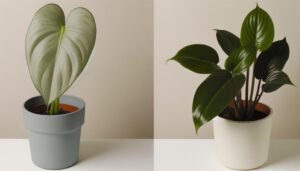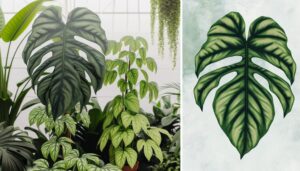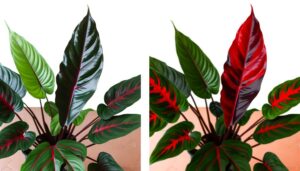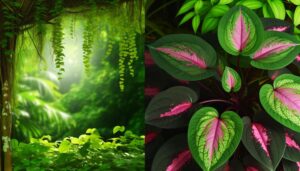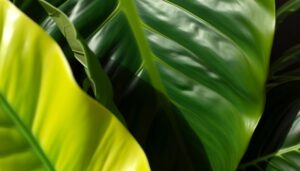Philodendron Mayoi Vs Selloum: Key Differences & Care Guide
Philodendron Mayoi and Philodendron Selloum, both native to the tropical regions of South America, exhibit distinct morphological characteristics. Philodendron Mayoi features feathery, lobed leaves with a bright green hue, whereas Philodendron Selloum presents substantial, glossy, pinnatifid foliage.
Mayoi manifests a compact, climbing growth habit using aerial roots, contrasting with Selloum’s self-heading, bushy structure. Light requirements slightly differ, with Mayoi preferring bright, indirect light, and Selloum adapting to partial shade.
Both species necessitate well-aerated, nutrient-rich soil and benefit from elevated humidity levels. Exploring further reveals nuanced care practices and the ecological benefits provided by these Philodendrons.

Key Takeaways
- Philodendron Mayoi has feathery, lobed leaves, while Selloum has large, glossy, pinnatifid foliage.
- Mayoi climbs with aerial roots; Selloum is self-heading and bushy.
- Mayoi thrives in bright, indirect light; Selloum adapts to partial shade.
- Mayoi prefers consistently moist soil; Selloum likes slightly dry soil between waterings.
- Mayoi is ideal for small spaces; Selloum requires more room to grow.
Characteristic of Philodendron Mayoi vs Selloum
| Characteristic | Philodendron Mayoi | Philodendron Selloum |
|---|---|---|
| Leaf Shape & Texture | Deeply lobed, feathery leaves with a more delicate appearance. | Large, broad, deeply lobed leaves with a glossy texture. |
| Leaf Size | Smaller, narrower leaves compared to Selloum. | Larger leaves that can grow up to 3 feet long. |
| Growth Habit | Upright and compact, can develop a climbing habit. | Grows upright but can spread out, forming a large, bushy plant. |
| Size | Stays smaller indoors, typically 2-4 feet tall. | Can grow much larger, up to 5-6 feet indoors and even bigger outdoors. |
| Light Requirements | Prefers bright, indirect light but can tolerate lower light conditions. | Thrives in bright, indirect light but can handle some low light. |
| Care Difficulty | Easy to care for, great for beginners. | Low-maintenance but requires ample space as it grows. |
| Native Region | Native to Brazil’s tropical regions. | Native to South America, commonly found in warm, tropical environments. |
Origins and History
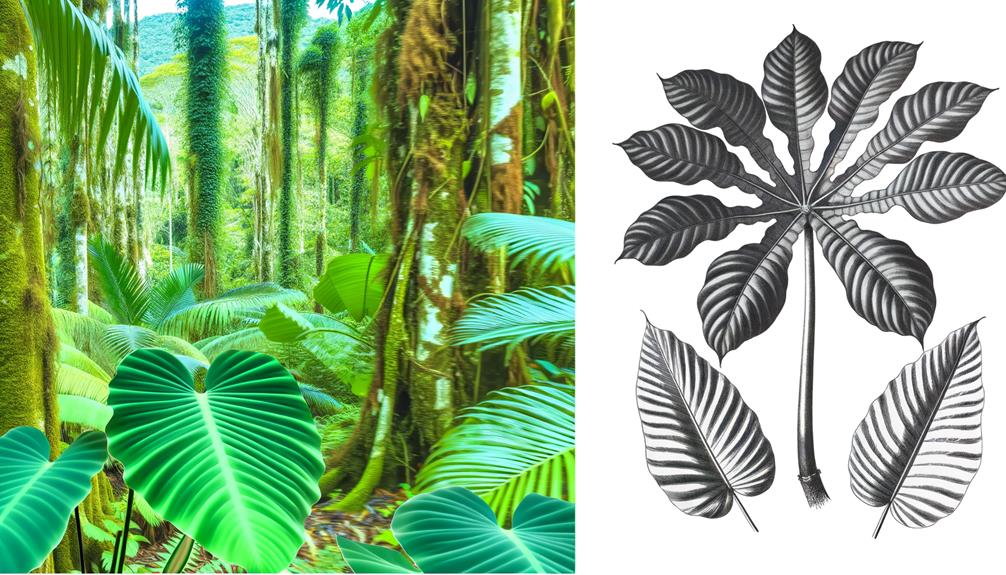
The Philodendron Mayoi, native to the tropical rainforests of Brazil, and the Philodendron Selloum, originating from the regions of South America, both belong to the diverse Araceae family and have distinct historical trajectories in botanical studies.
The Philodendron Mayoi was first classified by Heinrich Wilhelm Schott, an Austrian botanist known for his extensive work on the Araceae family. In contrast, the Philodendron Selloum, also known as Philodendron bipinnatifidum, was documented by Carl Friedrich Philipp von Martius, a German botanist who explored the flora of Brazil.
These species have been integral to understanding the ecological diversity and adaptive strategies of Araceae plants, contributing significantly to our knowledge of tropical flora evolution and biogeography.
Appearance and Foliage
Regarding morphological characteristics, Philodendron Mayoi displays deeply lobed, feather-like leaves, whereas Philodendron Selloum showcases large, glossy, pinnatifid foliage with a more pronounced ruffled texture.
The distinct differences in leaf morphology between these two species are notable and can be summarized as follows:
- Philodendron Mayoi: Exhibits elongated, slender lobes with a feathery appearance.
- Philodendron Selloum: Features broad, undulating leaves with a shiny, leathery surface.
Leaf Color: Mayoi’s foliage is typically bright green, while Selloum’s may range from dark green to a vibrant, glossy hue.
Size: Selloum leaves are generally more substantial and robust compared to the delicate structure of Mayoi leaves.
Veining: Prominent veining is more noticeable in Selloum, adding to its textured appearance.
Growth Habits

Understanding the growth habits of Philodendron Mayoi and Philodendron Selloum reveals significant distinctions in their developmental patterns and structural tendencies.
Philodendron Mayoi exhibits a more compact growth habit, often characterized by its tendency to produce elongated, pinnate leaves that extend horizontally. It typically climbs using aerial roots, favoring a supportive structure such as a moss pole.
In contrast, Philodendron Selloum displays a more expansive growth, developing into a larger, self-heading plant. Its substantial, lobed leaves emerge from a central stem, forming a dense, bushy appearance. Selloum’s growth is more upright and doesn’t require additional support.
These growth habits result in varied space requirements and aesthetic impacts within horticultural settings, making each species uniquely suited to different environmental conditions and design preferences.
Light Requirements
In examining the light requirements for Philodendron Mayoi and Selloum, it is essential to address their best light conditions, shade tolerance, and indoor light preferences.
Philodendron Mayoi typically thrives in bright, indirect light, whereas Selloum exhibits greater adaptability to varying light levels, including partial shade.
Understanding these distinctions is necessary for cultivating these species in both residential and botanical settings.
Optimal Light Conditions
While both Philodendron Mayoi and Philodendron Selloum thrive in bright, indirect light, their tolerance to lower light conditions differs significantly. Philodendron Mayoi benefits from consistent exposure to filtered sunlight, which promotes optimal photosynthesis and healthy growth. Conversely, Philodendron Selloum demands slightly more light to maintain its lush foliage and robust structure.
For both species, avoiding direct sunlight is essential to prevent leaf scorch and damage.
Best light conditions for both species include:
- Bright, indirect light: Ideal for photosynthesis without causing leaf burn.
- Filtered sunlight: Preferably through sheer curtains or partial shading.
- Consistent light levels: To guarantee uniform growth and development.
- Avoidance of direct sunlight: Prevents potential photodamage.
- East or north-facing windows: Provide suitable light intensity without overexposure.
Understanding these conditions is crucial for maintaining plant health.
Shade Tolerance Comparison
Philodendron Mayoi shows a greater tolerance for lower light conditions compared to Philodendron Selloum, making it more adaptable to shaded environments. The adaptability of Philodendron Mayoi can be attributed to its physiological and morphological characteristics, including wider leaves and a higher chlorophyll concentration, which enhance its photosynthetic efficiency in subpar light.
In contrast, Philodendron Selloum, while still capable of surviving in lower light, shows a preference for brighter conditions to maintain optimal growth and foliage health. The varying shade tolerance between these species emphasizes the importance of considering individual light requirements when growing these plants in environments with limited natural light.
Understanding these differences helps in making well-informed horticultural decisions, promoting strong plant health and vitality.
Indoor Light Preferences
Evaluating the indoor light preferences of Philodendron Mayoi and Philodendron Selloum reveals distinct requirements for best growth and development. Philodendron Mayoi thrives in bright, indirect light, mimicking its natural understory habitat. Conversely, Philodendron Selloum adapts well to moderate light but can tolerate lower light conditions better than Mayoi. Understanding these preferences can optimize plant health and foliage vibrancy.
- Philodendron Mayoi: Prefers bright, indirect light.
- Philodendron Selloum: Tolerates moderate to low light.
- Light Duration: Both species benefit from 12-14 hours of light daily.
- Artificial Lighting: Supplemental grow lights can aid during low natural light periods.
- Light Stress: Both species exhibit leaf yellowing under excessive direct sunlight.
These insights facilitate effective cultivation of both species indoors.
Watering Needs
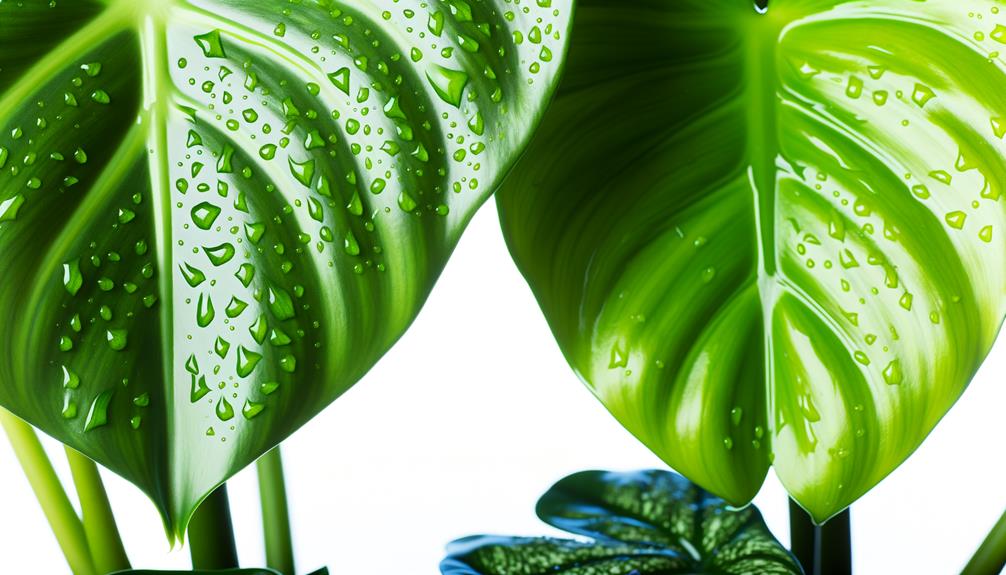
Understanding the distinct watering requirements for Philodendron Mayoi and Selloum is essential to fostering their best growth and health. Philodendron Mayoi thrives with a moderate watering schedule, ensuring the soil remains consistently moist but not waterlogged. In contrast, Philodendron Selloum prefers a slightly drier environment between waterings to prevent root rot.
| Plant Type | Watering Frequency | Soil Moisture Level |
|---|---|---|
| Philodendron Mayoi | Moderate, every 1-2 weeks | Consistently moist, not wet |
| Philodendron Selloum | Moderate, every 1-2 weeks | Slightly dry between waterings |
Both species benefit from using room-temperature water to avoid shocking the roots. Over-watering can lead to detrimental conditions such as root rot, while under-watering can cause leaf tip browning. Regular monitoring of soil moisture and adjusting the watering schedule based on seasonal changes is recommended.
Soil Preferences
In addition to their unique watering needs, the soil composition for Philodendron Mayoi and Selloum must be carefully tailored to optimize their growth conditions. Both species thrive in well-aerated, nutrient-rich substrates that facilitate prime root health and nutrient uptake.
Specifically, the soil mixture should include:
- Organic matter: Enhances nutrient availability and water retention.
- Perlite or pumice: Improves aeration and drainage, preventing root rot.
- Composted bark: Adds structure and assists in moisture retention.
- Coco coir: Provides a sustainable alternative to peat moss, offering excellent moisture retention.
- Activated charcoal: Helps in reducing soil impurities and maintaining a neutral pH.
Such components guarantee an ideal balance of moisture, aeration, and nutrient availability, promoting robust growth and overall plant health.
Humidity Tolerance
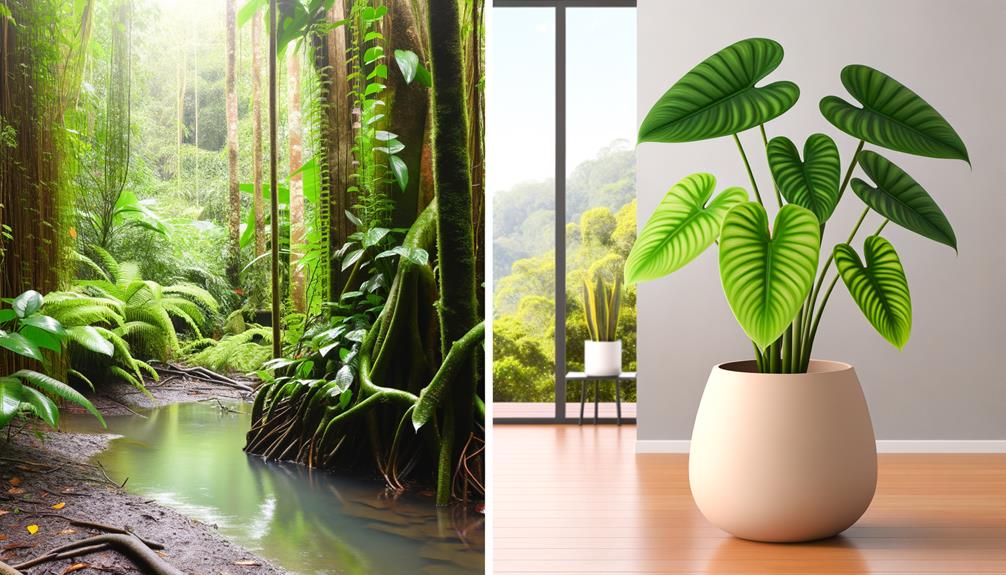
Both Philodendron Mayoi and Selloum exhibit a high tolerance for elevated humidity levels, which is necessary for replicating their native tropical environments. Best humidity levels for these species range between 60% to 80%. High humidity facilitates physiological processes such as transpiration and nutrient uptake, promoting lush foliage and vigorous growth.
Philodendron Mayoi, with its finely lobed leaves, and Philodendron Selloum, characterized by its large, deeply lobed leaves, both benefit from consistent moisture in the air. Insufficient humidity can lead to issues such as leaf browning and reduced growth rates. To maintain ideal conditions, the use of humidifiers or regular misting can be employed.
Therefore, understanding their humidity needs is vital for successful cultivation.
Temperature Range
Optimal temperature conditions are crucial for the thriving growth of Philodendron Mayoi and Selloum, with both species favoring a range between 65°F to 80°F (18°C to 27°C). Maintaining this specific temperature range ensures peak physiological functions, such as photosynthesis and nutrient uptake. Deviations below or above this range may induce stress, affecting overall plant health.
Key temperature considerations include:
- Consistency: Fluctuations should be minimized to prevent shock.
- Night and Day Cycles: Slightly cooler nights simulate natural environments.
- Humidity Interplay: High temperatures require increased humidity.
- Seasonal Variations: Gradual changes are preferable over abrupt shifts.
- Indoor vs. Outdoor: Indoor settings often provide more stable conditions.
Understanding these parameters aids in cultivating robust and vibrant specimens of Philodendron Mayoi and Selloum.
Maintenance and Care
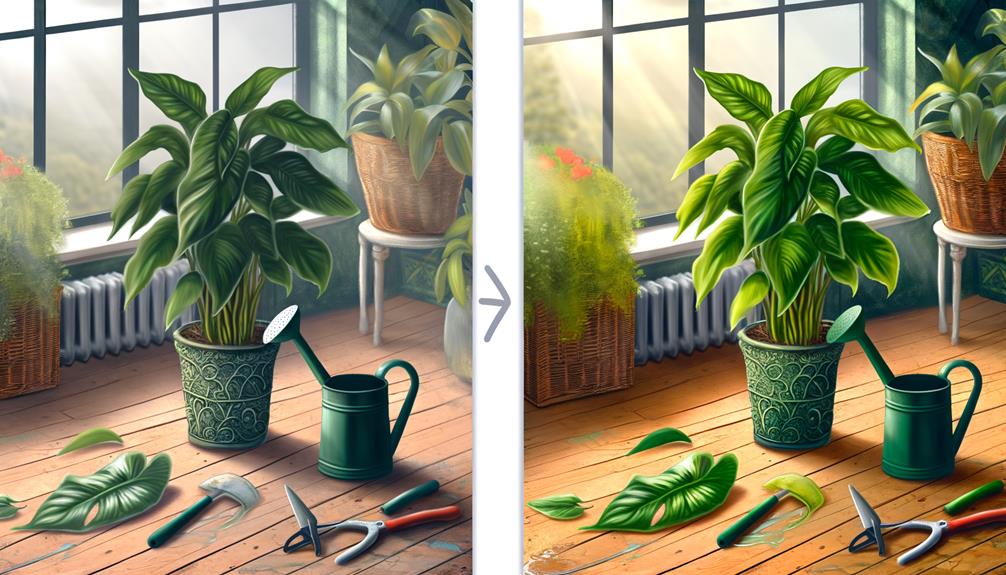
In addressing the maintenance and care of Philodendron Mayoi and Philodendron Selloum, it is essential to examine their distinct watering and light requirements, alongside best soil composition and fertilization practices.
Both species necessitate specific hydration schedules and light exposure for robust growth, with variations in their tolerances to moisture and light intensity.
Additionally, the choice of soil mix and the frequency of nutrient supplementation via fertilization play pivotal roles in their overall health and development.
Watering and Light Needs
Philodendron Mayoi and Selloum exhibit distinct requirements concerning watering frequency and light exposure to promote growth and health.
Philodendron Mayoi prefers indirect, bright light, which resembles the dappled sunlight of its native habitat. Mayoi requires consistently moist soil but must avoid waterlogging.
On the other hand, Philodendron Selloum thrives in moderate to bright indirect light but can tolerate lower light conditions. Selloum benefits from allowing the top inch of soil to dry out between waterings.
Both species should avoid direct sunlight to prevent leaf burn.
These distinctions guarantee excellent health and vitality.
Soil and Fertilization
While light and watering requirements are foundational, understanding the specific soil composition and fertilization regimen for Philodendron Mayoi and Selloum is equally vital for their best growth and maintenance.
Philodendron Mayoi thrives in well-draining, aerated soil with organic matter, promoting root oxygenation and moisture retention. A blend of peat moss, perlite, and orchid bark is ideal.
Selloum, alternatively, prefers slightly acidic, loamy soil rich in organic material, encouraging robust root development.
Fertilization for both species requires a balanced, water-soluble fertilizer, applied bi-monthly during the growing season. However, reducing fertilization during dormant periods is recommended to prevent nutrient toxicity.
Employing these soil and fertilization practices ensures optimal growth and overall plant health for both Philodendron species.
Common Pests
Both Philodendron Mayoi and Selloum are susceptible to common pests such as spider mites, aphids, and mealybugs, which can cause significant damage if not promptly addressed. These pests feed on plant sap, leading to weakened growth and potential disease transmission. Identifying and managing these pests is essential for maintaining plant health.
Notable symptoms include:
- Spider mites: Webbing on leaves, stippled yellowing, and leaf drop.
- Aphids: Sticky honeydew deposits, curled leaves, and stunted growth.
- Mealybugs: Cotton-like masses on stems and leaves, reduced vigor.
- Scale insects: Hard, shell-like coverings on stems, yellowed foliage.
- Thrips: Silvery streaks on leaves, distorted new growth.
Implementing integrated pest management strategies, including regular monitoring and biocontrol agents, can mitigate infestation risks effectively.
Propagation Methods
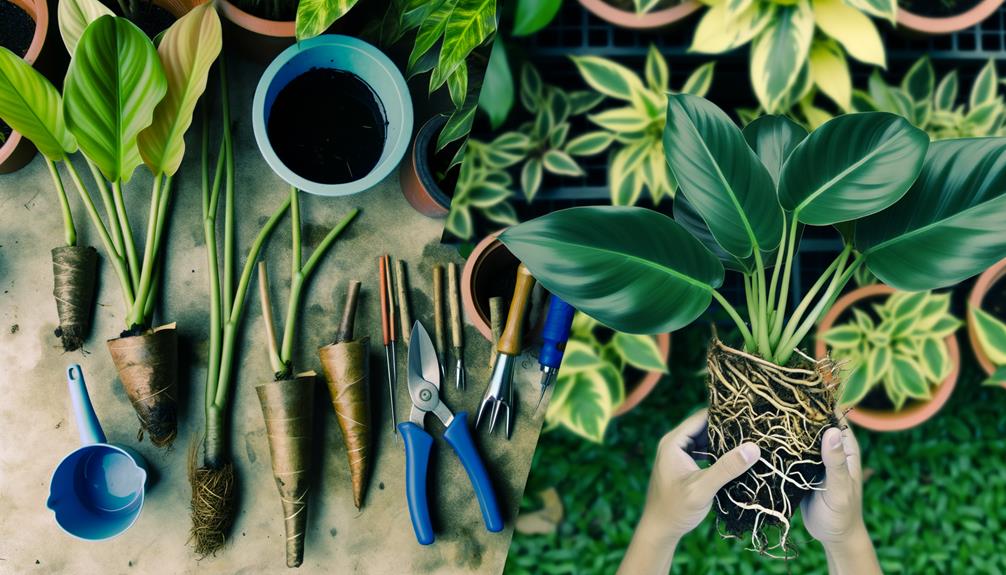
Propagation of Philodendron Mayoi and Selloum primarily involves stem cutting techniques. This process requires precise incisions below the node to guarantee successful growth. These cuttings can subsequently be rooted in water, an effective medium for the development of robust root systems before transplantation into soil.
This method capitalizes on the plants’ innate ability to regenerate, thereby facilitating clonal propagation.
Stem Cutting Techniques
Stem cutting techniques for Philodendron Mayoi and Selloum involve precise incisions below a node to ensure root development and plant health. The process requires careful attention to detail to maximize success rates. Proper tools and conditions are crucial to prevent infection and promote ideal growth.
Key steps include:
- Sterilizing cutting instruments: Prevents pathogen transmission and guarantees clean cuts.
- Selecting healthy stems: Choose stems with strong, disease-free nodes.
- Making the cut: Execute an angled incision below a node to enhance rooting potential.
- Application of rooting hormone: Encourages faster root development by stimulating cellular activity.
- Providing sufficient humidity and light: Essential for the initial stages of root formation and plant acclimatization.
Adhering to these techniques promotes successful propagation of both Philodendron varieties.
Rooting in Water
Rooting Philodendron Mayoi and Selloum in water involves submerging cuttings in a controlled aquatic environment to facilitate root development and promote plant health. This propagation method requires precise conditions: clean water, indirect light, and a stable temperature of approximately 21-24°C (70-75°F).
Cuttings should be taken just below a node, ensuring at least one leaf remains above water. It is advisable to change the water every 3-5 days to prevent bacterial growth. Observations indicate that roots typically begin to emerge within two to four weeks.
This method is advantageous for visual monitoring of root progress and enables early detection of any potential issues, ensuring ideal conditions for successful root establishment.
Best Uses Indoors
When considering the best uses of Philodendron mayoi and Selloum indoors, it is imperative to evaluate their light requirements, spatial needs, and aesthetic contributions to interior environments.
Both species thrive under indirect light, making them suitable for various indoor settings.
Philodendron mayoi, with its finely divided leaves, offers a delicate touch, ideal for modern and minimalist designs.
In contrast, Selloum, with its large, lobed leaves, provides a bold statement in spacious areas.
- Indirect Light Tolerance: Ideal for rooms with filtered sunlight.
- Air Purification: Both species contribute to improved indoor air quality.
- Spatial Requirements: Philodendron mayoi requires less space, suitable for compact areas.
- Aesthetic Versatility: Complements various interior design styles.
- Low Maintenance: Minimal care needs make them accessible for busy professionals.
Conclusion
To sum up, Philodendron mayoi and Selloum present distinct characteristics, each offering unique aesthetic and horticultural benefits. The choice between these two species hinges on specific environmental conditions and individual care preferences.
For instance, a botanical study on a controlled indoor environment revealed Philodendron mayoi’s superior adaptability to low light conditions, while Selloum thrived under bright, indirect light. This distinction underscores the importance of understanding species-specific needs, ensuring best growth and contributing to the overall biodiversity of indoor plant collections.

